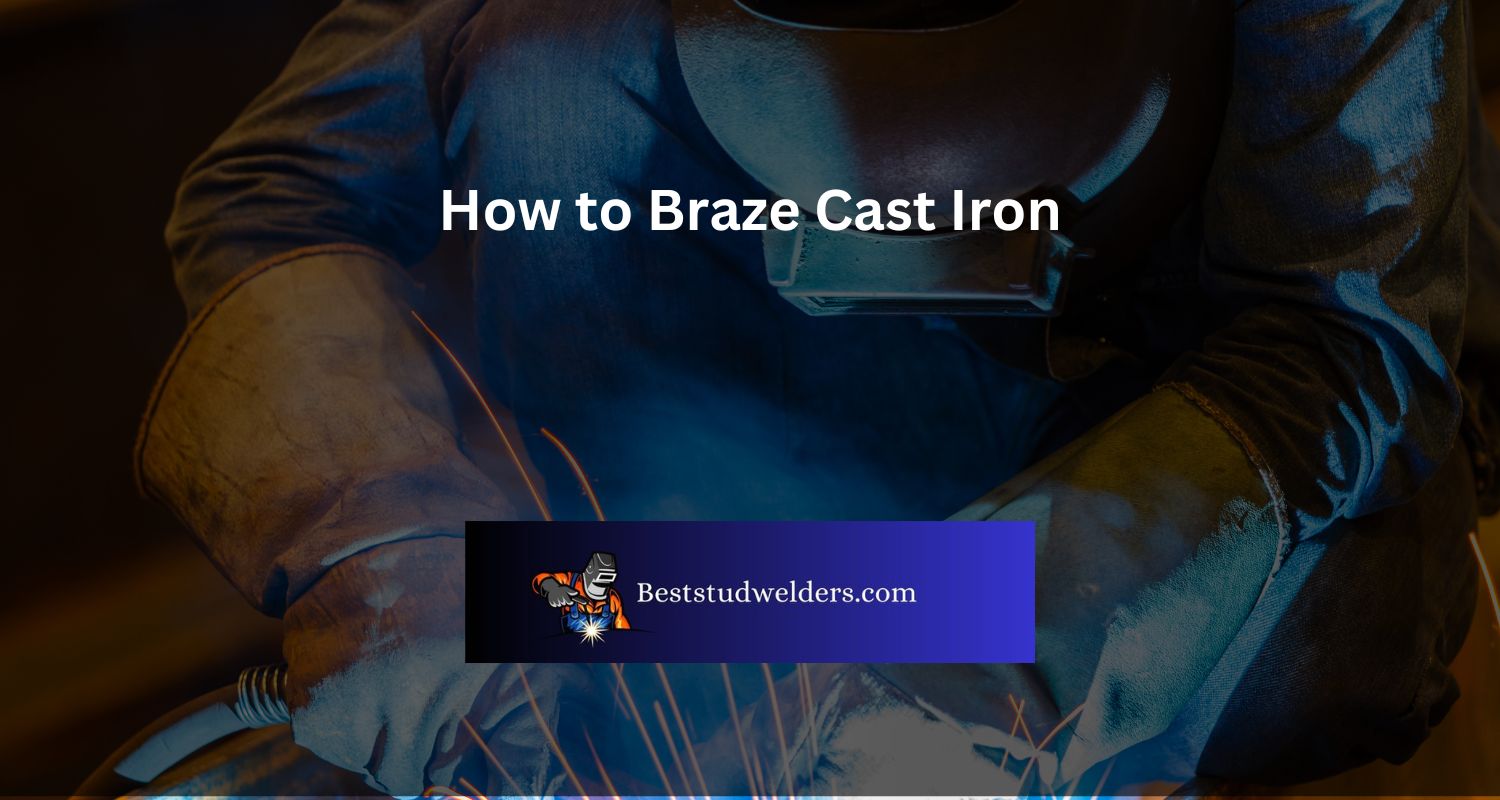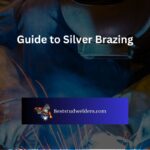Brazing cast iron is a surprisingly simple process that, once mastered, can open the door to all sorts of possibilities in metalworking and construction.
Done correctly, brazing cast iron is an incredibly strong bond with excellent corrosion resistance.
For professionals looking to add another skill set to their repertoire or hobbyists looking for something new to try out this complete guide on how to braze cast iron will provide a comprehensive introduction into the successful execution of this important technique.
Get ready and let’s explore exactly what it takes to create quality brazed joints!
Understanding Braze Welding
Braze welding is a process of joining two metals together with heat and a filler material. It’s important to know the melting points of the metals being joined, as this determines the necessary heat for bonding.
You also need to select an appropriate flux to remove oxidation from the metals. Maintaining joint visibility is important for proper placement of the filler material.
Before brazing, especially for cast iron, prepping surfaces is essential. Clean the areas intended for brazing with a wire brush or sandpaper. Apply flux in the clean areas and clamp the components together tightly. Using a low fuming bronze rod, weld at below 2,000 degrees Fahrenheit.
Pro Tip: Be careful when heating and cooling the brazed metal components. Sudden temperature changes can cause warping and cracking, so cool the welded parts down gradually before use. Get ready to get hot and heavy with some cast iron!
Preparing for Braze Welding
To prepare for braze welding in cast iron, it is essential to clean the metal surface thoroughly, heat it to the ideal temperature, and select the appropriate filler metal. In this section, we will discuss these three critical sub-sections that would help you to achieve a successful braze weld. Let’s explore how to clean the cast iron, heat the metal, and choose the right filler metal necessary for braze welding.
Cleaning the Cast Iron
Eliminating Debris from Cast Iron Surface
To get a spotless surface for braze welding, it’s necessary to take out all debris and contaminants from the cast iron. Here’s a 4-step guide to sprucing up the cast iron:
- Start by having a close look at the metal’s surface for rust or paint. If there’s any, scrub it off with a wire brush, sandpaper, or a grinder.
- Clean the surface with a light solvent such as acetone or denatured alcohol. Use a non-abrasive cloth dipped in solvent for taking out all dirt and oils.
- Later, use compressed air to blow away loose particles and residue in a well-ventilated area, under low pressure to stop damage to yourself or objects around.
- Lastly, inspect the cleaned cast iron one more time before beginning braze welding.
Also, never dip the cleaned cast iron in water as it’ll cause corrosion and weaken its strength.
Pro Tip: Put on PPE when you’re doing braze welding activities near hot metals or open flames to guard your skin and eyes from harm.
Don’t hesitate to raise the temperature when heating cast iron for braze welding; it won’t mind.
Heating the Cast Iron
To prepare cast iron for braze welding, the first step is to evenly and steadily heat it. Heat it correctly to avoid damage or cracks. Follow this 5-step guide:
- Preheat the oven – 500°C (932°F).
- Place the Cast Iron in Oven – Bake for approx. one hour.
- Maintain Temperature – Regulate by diffusing heat between parts.
- Remove from Oven- Take out cautiously.
- Apply Flux– Place flux on areas you intend to braze weld.
You can also use gas torches. Pro Tip: Be patient while heating. Don’t overheat or it’ll cause more harm. Choose the right filler metal – it needs to complement and strengthen.
Choosing the Right Filler Metal
When it comes to braze welding, there are a few factors to consider such as the base metal composition, joint design, and mechanical properties. A table can help outline these needs. The base metal composition determines compatible or dissimilar filler, joint design dictates the type of filler, and the mechanical properties affect the amount of filler.
Heat input and corrosion resistance should also be taken into account. When selecting a filler metal, the melting point should be considered. It’s interesting to note that brazing has been around since ancient times.
Today, modern brazing was developed in the early 1900s with metallurgy and welding advances. If you thought brazing was just for jewelry, you can use it to wield fire like a pro.
.jpg)
Braze Welding Techniques for Cast Iron
To master the art of braze welding techniques for cast iron, you need to understand the different methods available. This will help you choose the best solution for you. Torch Brazing, Furnace Brazing, and Induction Brazing, are three sub-sections we will explore.
Each method has its own advantages and unique features that will make your braze welding process more efficient and effective.
Torch Brazing
Gas Torch Brazing, commonly referred to as brazing with a handheld torch, is an effective and practical approach for welding Cast Iron. It’s often used for smaller components such as electrical boxes, pipes, and furnace components.
To comprehend Torch Brazing, we can create a Table of steps. This includes:
- Prepping the Cast Iron and Filler Alloy.
- Cleaning the Base Metal Surface with Flux coated Torch Brazing Rods.
- Igniting the Torch with Butane or Propane gas.
- Applying Heat Gradually by passing the flame over the metals until they reach melting point.
- Applying Fillers along Joint Edges while ensuring adequate distribution to avoid gaps.
Braze Welders must utilize Clean Base Metals because Cast Iron tends to be oil-absorbent and Porous. Also, they must possess some knowledge of Metallurgy Fundamentals since brazed joints can sometimes be porous enough to leak.
I once had to repair my neighbor’s Grandfather Clock which required extensive welding work done on its Cast Iron faceplate. I applied Torch Brazing techniques to the job – furnace brazing because sometimes you just need to heat things up to make them stick together.
Furnace Brazing
High-temperature furnace joining is a highly effective technique for connecting cast iron parts. This involves placing the workpiece in a furnace at very high temperatures. Then, a brazing alloy is used to fill any gaps and fuse with the workpiece. Here are some details about furnace brazing:
- Temperature: 1200°C to 1260°C
- Atmosphere: Controlled
- Filler Metal: High melting point alloys
Furnace brazing is easier than manual labor and precision methods like gas torch welding. It also allows for uniform heating of all components. Brazing dates back to ancient Egyptian times. Craftsmen used copper-based filler metals and simple fuels as heat sources. Nowadays, complex alloys that can withstand temperature and pressure are used for industrial applications. Induction brazing is the only way to heat things without playing with fire or getting burned.
Induction Brazing
Electromagnetic brazing is a process that uses high-frequency electromagnetic fields to generate heat and join two metals. A filler metal is melted into the spaces between the two contact points, and then cooled down.
Benefits of induction brazing include energy efficiency, precision brazing, and high joint quality. Plus, it’s easy to automate, reduces production time, and is repeatable.
One machining firm used induction brazing to repair a broken engine block instead of replacing it. This saved time and money, since they could weld onsite without having to remove or replace parts. With the right induction heating source, brazing alloys selection, and welding techniques application, they were able to meet OEM’s specifications with a strong-performing engine block.
And last, but not least, don’t forget the most important step – admiring your handiwork while sipping on a cold one!
Post-Braze Welding Steps
To ensure a successful brazing process for cast iron in “post-braze welding steps”, cleaning the brazed area, inspecting the welded area and stress-relieving are crucial. These steps will ensure that the braze joint is safely sealed and that the weld has a neat and finished appearance.
Cleaning the Brazed Area
To ensure a clean finish, it’s key to clean the brazed area properly. This is vital for a strong joint and great results. Follow these 3 steps:
- Use a wire brush or abrasive pad to get rid of any extra flux or residue from the surface.
- Wipe down the area with acetone or another suitable solvent to take away any remaining contaminants.
- If needed, use a grinder or file to make any rough spots in the joint smooth.
It’s important to remember to clean immediately after brazing. Waiting can cause tougher residue to remove. Using a degreaser or alkaline cleaner before brazing can also help stop contamination and better adhesion between the filler metal and base metals. Proper handling and storage of materials can lower contamination and increase overall quality of the brazed joint.
Checking your welding job is like going to the doctor: you never know what you’ll discover, but it’s always better to catch it early.
Inspect the Welded Area
After braze welding, inspecting the area is key for product quality and safety standards. If overlooked, it could lead to serious hazards. Here’s a 5-step guide to inspect the welded area:
- See any visible deformities
- Look at joint penetration
- Find any discontinuities in the weld fusion area
- Do non-destructive testing (NDT) if suggested by your industry expert
- Conduct final visual inspection as per industry-approved practices
While inspecting, consider factors like surface finish, metal hardness, and joint dimensions. Also, check that welding materials are not stressed or cracked and welding surfaces are free of dirt and grease.
Evaluating NDT results needs proper interpretation. Ask an expert if you need help.
Don’t skimp on the inspection after braze welding. It’s important not only for quality, but also regulatory compliance for many industries. If only stress relief was as easy as a post-braze welding step!
Stress-Relieving
Releasing stress from welded components is essential for them to work properly. We do this by heating the welds at high temperatures – a process known as stress-relieving.
We must control the temperature and duration of the heating to avoid any risks. The aim is to even out the microstructure, enabling strains to relax and spread uniformly. This leads to dimensional stability and long-term structural integrity.
Not all welded components need stress-relieving, but it’s best practice for parts under high load or temperature. When done alongside other post-welding processes, it ensures optimal performance.
Pro Tip: Make sure to get qualified personnel with heat treatment experience to carry out stress-relieving.
And remember: safety is key when braze welding cast iron – otherwise you could end up with iron in your blood!
Safety Considerations for Braze Welding Cast Iron
When braze welding cast iron, safety is key! Ensure proper ventilation in the workspace. Wear protective gear such as gloves and a face mask. This protects you from toxic gases and flying debris.
Be cautious of the heat generated during brazing. This could cause burns or ignite flammable objects. Have fire extinguishing equipment handy.
Before starting, make sure you know what you’re doing! Lack of experience could lead to accidents.
A cautionary tale: A novice welder once attempted to repair a tractor engine without taking necessary precautions. Result? Burns and suffocation. So take safety seriously when braze welding cast iron. Minimize risks by following proper protocols.
Frequently Asked Questions
Q: Can you braze cast iron?
Yes, cast iron can be brazed using a low-temperature brazing rod and a gas torch.
How do I prepare the cast iron surface for brazing?
The cast iron surface should be cleaned with a wire brush or sandpaper to remove any rust or debris. A flux should also be applied to the joint area to help the brazing rod adhere to the metal.
What kind of brazing rod should I use for cast iron?
A low-temperature brazing rod made of nickel or nickel alloy is recommended for brazing cast iron.
How do I braze cast iron without warping it?
To avoid warping, heat the metal slowly and evenly with a gas torch, and use a light touch when applying the brazing rod. It is also recommended to cool the metal slowly after brazing, using a heat-absorbing material such as sand or ashes.
Can I braze cast iron if it has a crack?
Yes, cracks in cast iron can be brazed using a low-temperature brazing rod. However, the crack should be properly cleaned and prepared before brazing, and it is recommended to reinforce the joint with additional brazing rod.
Paul Dixon is a certified welder with a wealth of experience in welding and related technologies. He started his career as an apprenticeship in welding, where he learned the ropes and acquired extensive skills in the craft.
Over the years, Paul has continued to sharpen his expertise, earning him top-rated welding certification. He remains one of the most outstanding welders in the industry.







